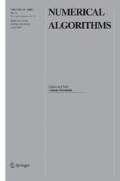Abstract
A triangular graph is a planar graph in which each face is a 3-cycle, except possibly for the exterior face, and without articulation nodes. The embedding of a triangular graph in the plane is called a triangular mesh. More generally, a triangular graph with multiple contours is a planar graph without articulation nodes in which each face is a 3-cycle, except possibly for a fixed number of them. A contraction along an edge in a graph is the result of identifying the two endpoints of the edge. In this paper a necessary and sufficient condition is shown for which triangularity (possibly with multiple contours) is preserved after contraction. Moreover, when a licit contraction is performed, the question to answer is whether or not it is possible to derive the embedding of the contracted triangular graph from the original triangular mesh by redrawing only around the contraction zone.
Similar content being viewed by others
References
K. Deljouie-Rakhshandeh, An approach to the generation of triangular grids possessing few obtuse triangles, Numer. Methods Engrg. 29 (1990) 1299–1321.
L. R. Foulds,Graph Theory Applications (Springer, 1994).
P.-L. George and J.-M. Nizard, Maillage aigu, Technical Report # 1414, INRIA, Le Chesnay, France (1991).
J. L. Gross and T. W. Tucker,Topological Graph Theory, Wiley-Interscience Series in Discrete Mathematics and Optimization (Wiley, New York, 1987).
F. Harary,Graph Theory (Addison-Wesley, 1969).
G. R. Kampen, Orienting planar graphs, Discrete Math. 4 (1976) 337–341.
M. S. Milgram, Does a point lie inside a polygon?, Comput. Phys. 84 (1989) 134–144.
T. Nishizeki and N. Chiba,Planar Graphs: Theory and Algorithms, Annals of Discrete Mathematics 32 (North-Holland, 1988).
R. C. Read, A new method for drawing a planar graph given the cyclic order of the edges at each vertex, Congr. Numer. 56 (1987) 31–44.
W. Schnyder, Embedding planar graphs on the grid, in:Proc. 1st Annual ACM-SIAM Symposium on Discrete Mathematics (1990) pp. 138–148.
C. Wooff, Checking whether a point lies inside a polygon, Comput. Phys. Comm. 36 (1985) 219–222.
F. Yamaguchi, A unified approach to interference problems using a triangle processor, in:Proc. ACM SIGGRAPH'85 (1985) pp. 141–149.
Author information
Authors and Affiliations
Additional information
Communicated by C. Brezinski
Part of this work was done when the author was in his sabbatical year at the University of California at Los Angeles.
Rights and permissions
About this article
Cite this article
Ciarlet, P., Lamour, F. Does contraction preserve triangular meshes?. Numer Algor 13, 201–223 (1996). https://doi.org/10.1007/BF02207695
Received:
Issue Date:
DOI: https://doi.org/10.1007/BF02207695




